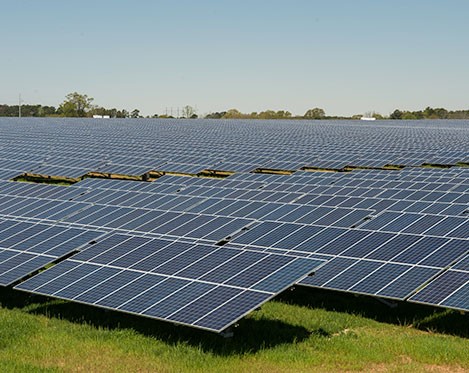Considering Solar
How can I find out if solar is right for me?
We offer a Solar Adviser tool that will ask you a series of questions to help you decide if a solar installation could be a good option for you. You will need your Georgia Power account number to complete this tool with the option to be contacted about installing solar. With your Georgia Power account number handy, please select "View Tool" below, to visit our Solar Advisor Tool and determine if solar is a viable option for your home.
How much does it cost to install a rooftop solar energy system?
System installation costs vary based on the size of your home, available mounting roof space, complexity of the roof design and budget. The amount of energy produced is based on several factors like: tilt angle, orientation, and shading conditions. The Solar Advisor Tool will help you estimate what a solar installation could cost as shown here.
SMALL
Below 1,600 Sq. Ft.
4kW System Size
Installation Cost
$10,080*
MEDIUM
1,600—3,499 Sq. Ft.
6kW System Size
Installation Cost
$15,120*
LARGE
$3,500+ Sq. Ft.
10kW System Size
Installation Cost
$25,200*
Does Georgia Power offer any incentives or rebates for residential solar installation?
Neither Georgia Power nor the State of Georgia currently offer any incentives or rebates for residential solar installations. However, there is a federal investment tax credit available for 30%. We would recommend speaking with an accountant or CPA to ensure you can take advantage of it when you file your taxes the next year. For more information, please visit the EnergyStar website.
What is the lifespan of panels and inverters?
Solar panels are warrantied for 25 years and typically last 30–35 years and generate electricity in the form of direct current (DC). There is another piece of equipment needed for the installation called the inverter, included with the system. The inverter converts the electricity from direct current (DC) to alternating current (AC). The inverter typically lasts 15–20 years; you may have to replace the inverter at some point during the life span of the solar panels, and that replacement cost is not included. Lastly, the inverter is wired directly into the breaker panel box. The installer would need to check the panel box to see if space is available.
Can I install my own interconnection transformer for my facility and what are the requirements?
The Distributed Energy Resources (DER) Owner may choose to install their own step-up or step-down transformer to match the renewables equipment voltage with the service voltage. For three-phase inverter-based DER interconnections, the DER-Owner transformer must have grounded-wye windings on the Company side and grounded-wye windings on the DER side, with no delta tertiary windings.
Will my solar panels continue to power my home during an outage?
No. Since your system would be grid-tied, for safety reasons, if there is a power outage your solar system will automatically shut off when the power goes out. If you have a solar battery system added to your solar PV system, your power will continue to work. Solar batteries can add as much as 30% to the cost of a solar system presently.
Does Georgia Power recommend any rooftop solar developers?
We typically recommend our customers begin by contacting a certified installer to perform an onsite evaluation of current conditions at your facility and to provide you with a proposal for a solar installation. It is best to obtain 2–3 proposals as solar installers may offer competitive pricing and financing.
Does Georgia Power partner with any rooftop solar developers?
No. Georgia Power does not have exclusive partnerships with solar developers, and customers should be wary of anyone making such claims. If a solar developer is claiming any partnership with Georgia Power, please provide any collateral to G2GPCRDI@SOUTHERNCO.com.
Fees
What is the witness test and interconnection fee?
The interconnection fee covers the costs associated with processing and managing the application, Witness Testing, and reprogramming the meter for projects <250kW AC. Projects >250kW AC will also have an additional Witness Testing fee.
How are witness test and interconnection fees paid?
For projects less than or equal to 250kW AC, the interconnection fee is added as a line item on the customer's bill after the interconnection process is completed.
Any projects that are greater than 250kW AC will also be charged a witness test fee billed to the customer through a Non-Electric Service Business (NESB). At this time, fees are charged to customers only.
RNR Program Guidance
What are the RNR program eligibility requirements?
Residential customers may install a system with a peak generating capacity of less than or equal to 10 kW AC. For more information, please review the RNR-11 Tariff.
How are customers credited through the RNR program?
RNR-Instantaneous Netting
In the RNR-Instantaneous Netting program, excess energy generated by a customer's solar panels are credited at the annual Solar Avoided Cost Rate per kilowatt hour (kWh), which is 3.3153¢/kWh for the year 2025. During the 2022 rate case, the Public Service Commission approved an additional 4¢/kWh that will be added to the annual solar avoided cost. The excess solar generation is summed monthly and will be used to reduce the customer's total monthly bill. This program is currently open for participation as further detailed in the RNR-11 Tariff.
More information about the solar avoided cost projects can be found on the Public Service Commission's website, dockets 4822 and 16573.
What is the cap for the RNR program?
RNR-Instantaneous Netting
Subscription to RNR-Instantaneous netting will be available to all eligible customers on a first come, first served basis until the cumulative generating capacity of all renewable sources equals to 0.2 percent (0.2%) of the Company’s annual peak demand in the previous year.
Billing
Why does my electric bill show less solar power than what my solar monitoring app shows?
Your solar monitoring app shows the total amount of solar energy generated by your system. However, your electric bill only shows the excess solar that goes back to the grid during that billing period as “kWh Rec”.
My solar company designed my system to offset most of my usage from the grid. Why is my bill so high?
Your energy usage and the amount of solar power generated fluctuates with the season. The solar will work best in the spring which coincides with the time of year when your energy usage is typically lower due to the milder temperatures of the season. In the spring, the amount of solar power you send back to the grid may be higher than what you use from the grid. If so, a Renewable Generation Credit will be paid for that excess energy. In the summer, your solar performance will continue, but your energy usage will likely increase due to air conditioning use during the heat of the summer. In the fall and winter, solar performance will decline due to overcast weather, and if you use electric heat, your usage may increase in the cold of the winter. When this happens, the amount of excess energy delivered to the grid is reduced because you are consuming more of the solar energy you are generating.
Will I always have a Georgia Power bill each month?
Yes, you will always receive a power bill. At a minimum, a basic service charge plus any other fees will be billed every month. Additionally, most solar customers do not offset all of their grid usage every month and continue to pay for electricity from the Georgia Power grid.
What does an Energy Offset Only bill look like?

What does a Residential Service bill look like on RNR-Instantaneous Netting?

What does a Plug-in Electric Vehicle bill look like on RNR-Instantaneous Netting?

What does a Residential Service bill look like on RNR-Monthly Netting?

PowerClerk Administration
How do I sign up for the RNR or Energy Offset Only program?
To participate in either program, you or your installer must fill out an application using PowerClerk, our interconnection for application tool. To get started with your application, please register to create an account. Check out the PowerClerk Interconnection Guide for an overview of the process.
Who should fill out the PowerClerk application?
Applications may be filled out by the installer or the customer and both parties may be granted access to view the project status. However, even if an installer assists or completes the online application, the interconnection agreement will be solely between Georgia Power Company and the Georgia Power customer. All applications will require the Georgia Power customer’s signature.
What information will be required to complete a PowerClerk application?
Information may be entered into the application as it is available, and the application will be automatically saved as changes and updates are made. Applications should not be submitted until the following information is included:
- Georgia Power customer information, including customer name, account number, and facility address.
- Facility and technical information, including a one-line drawing and panel and inverter specifications. If battery storage is included, battery specifications must also be provided.
- Installer information.
- Local inspection report (if applicable).
What are Georgia Power's requirements for rooftop solar installations?
Distributed energy generators should reference the following documents to ensure their facilities comply with the Company’s safety, reliability, operating and interconnection requirements:
- DER Parallel Operating Policy
- Georgia Power Blue Book
- Georgia Power Green Book [link to be added upon completion]
- RNR Tariff (for customers who choose to participate in this program)
Witness Testing
What is the purpose of a Witness Test
Witness Tests are conducted on most solar generators on Georgia Power’s distribution or transmission system to ensure generators meet the Company’s safety, reliability, and interconnection requirements.
Who contacts the customer and/or installer to schedule or reschedule the witness test?
For projects less than 250kW AC, the Witness Test is scheduled by a meter technician. The technician will reach out to the person listed as the Witness Test contact provided by the installer with an estimated date and time of arrival to perform the Witness Test. For projects larger than 250kW AC, the project coordinator will contact the customer and contractor two weeks in advance to schedule the Witness Test.
When will I receive permission to operate my system after my Witness Test passes?
Once the project has passed the Witness Test, the meter has been reprogrammed bidirectional and all documents are final, the project will be marked as “Project Complete.” An official Permission to Operate (PTO) letter will be emailed to both the Customer and the Installer. Attached to the email will be a copy of the Interconnection Agreement.
PTO approval is only valid for the original Customer of Record/ Georgia Power Account, original equipment installed, the original Total AC Nameplate Capacity, the original Point of Interconnection, and the active Renewable programs at the time of review. Any change in ownership or system modifications or additions after the project receives PTO, must be submitted as a new application to Georgia Power.




